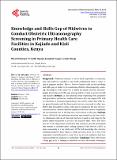| dc.contributor.author | Matiang’i, Micah | |
| dc.contributor.author | Ngunju, Priscilla | |
| dc.contributor.author | Nyagero, Josephat | |
| dc.contributor.author | Omogi, Jarim | |
| dc.date.accessioned | 2022-02-03T21:33:37Z | |
| dc.date.available | 2022-02-03T21:33:37Z | |
| dc.date.issued | 2020-06-30 | |
| dc.identifier.citation | Matiang’i, M., Ngunju, P., Nyagero, J. and Omogi, J. (2020) Knowledge and Skills Gap of Midwives to Conduct Obstetric Ultrasonography Screening in Primary Health Care Facilities in Kajiado and Kisii Counties, Kenya. Open Journal of Clinical Diagnostics , 10, 65-79. https://doi.org/10.4236/ojcd.2020.102006 | en_US |
| dc.identifier.issn | Online: 2162-5824 | |
| dc.identifier.issn | Print: 2162-5816 | |
| dc.identifier.other | DOI: 10.4236/ojcd.2020.102006 | |
| dc.identifier.uri | https://repository.amref.ac.ke/handle/123456789/579 | |
| dc.description | © 2020 by author(s) and
Scientific Research Publishing Inc.
This work is licensed under the Creative
Commons Attribution International
License (CC BY 4.0).
http://creativecommons.org/licenses/by/4.0/ | en_US |
| dc.description.abstract | Background: Ultrasound remains a tool of much importance in maternity
care with midwives regarded as key health professionals when it comes to
care of pregnant mothers. There is however limited study on the knowledge
and skills gaps of midwives in conducting obstetric ultrasonography screening.
The purpose of this study was to assess the specific obstetric ultrasonography
knowledge and skills gaps among midwives based in primary health
care facilities. Methods: A cross-sectional study employing both qualitative
and quantitative method was conducted between July and August 2019 with
274 midwives. A structured questionnaire was used to collect data while Focus
group discussion and Key Informants Interview were used to collect qualitative
data. Descriptive statistics were used to summarize the data test associations
between variables while the qualitative data were used to compliment
the questionnaire data in eliciting more information on the gaps. Findings:
Almost all (94.5%) the midwives had never been trained on any basic obstetric
ultrasound while six of those that had been trained in early stages by the
project lacked equipment to practice the acquired skills. More than three
quarters of the respondents opined that they wished to provide personalized
care services to mothers/clients seeking Antenatal Care Services (ANC) in
their community at a fee while only 13.9% had knowledge that obstetric
screening should be done before 24 weeks gestation. Four out of ten of the
respondents scored themselves a one (1) on the level of confidence they have
using an ultrasound machines or technology. Conclusion: There still remains
a huge gap as far as training of midwives on basic ultrasound screening is concerned. The lack of basic obstetric ultrasound screening skills is a barrier
to rolling out Point of Care Ultrasound (POCUS) screening services. However,
midwives are motivated and willing to learn basic ultrasonography skills
to further the objectives of Universal Health Coverage (UHC). Concerted efforts
should be made to train midwives on basic obstetric ultrasonography
skills in addition to availing mobile/hand held ultrasound technology in Primary
Health facilities for them to apply the transferred skills. A sustainable
business model to enable mothers continuously afford the services is critical
as well. | en_US |
| dc.description.sponsorship | Phillips Foundation | en_US |
| dc.language.iso | en | en_US |
| dc.publisher | Scientific Research Publishing | en_US |
| dc.subject | Antenatal Care | en_US |
| dc.subject | Basic Ultrasound Screening | en_US |
| dc.subject | Midwives | en_US |
| dc.subject | Primary Health Care | en_US |
| dc.title | Knowledge and Skills Gap of Midwives to Conduct Obstetric Ultrasonography Screening in Primary Health Care Facilities in Kajiado and Kisii Counties, Kenya | en_US |
| dc.type | Article, Journal | en_US |

